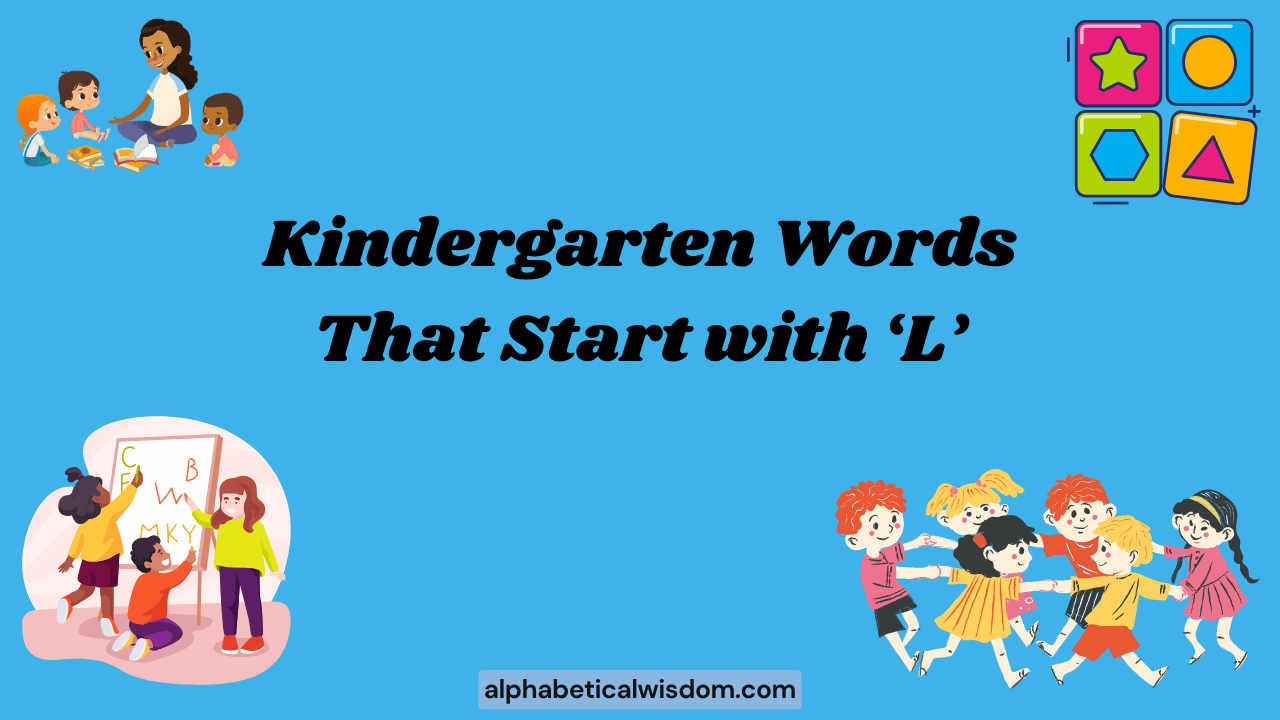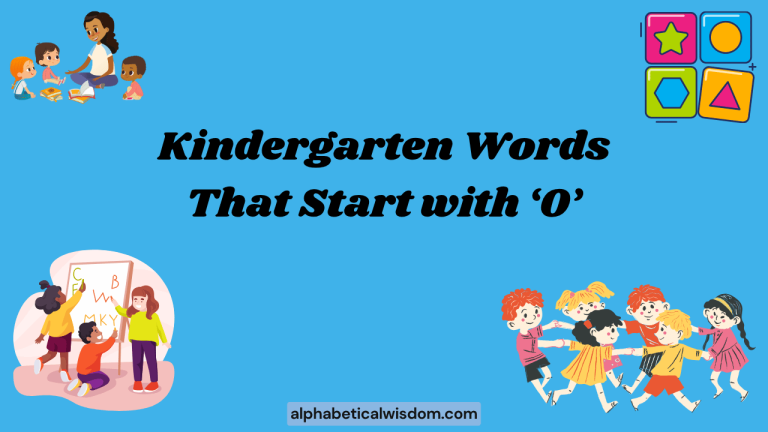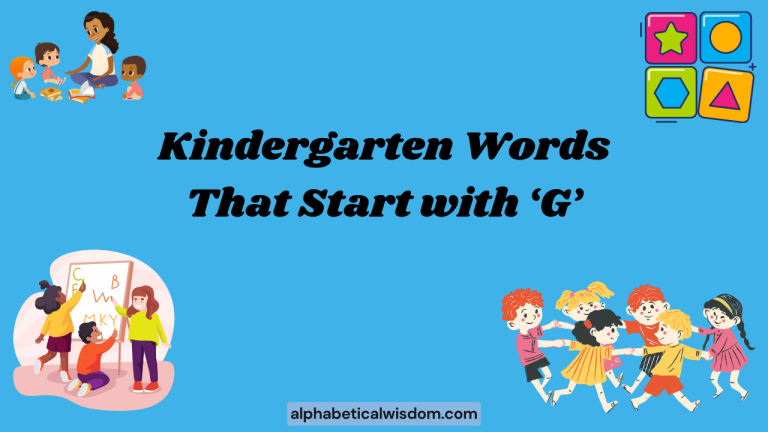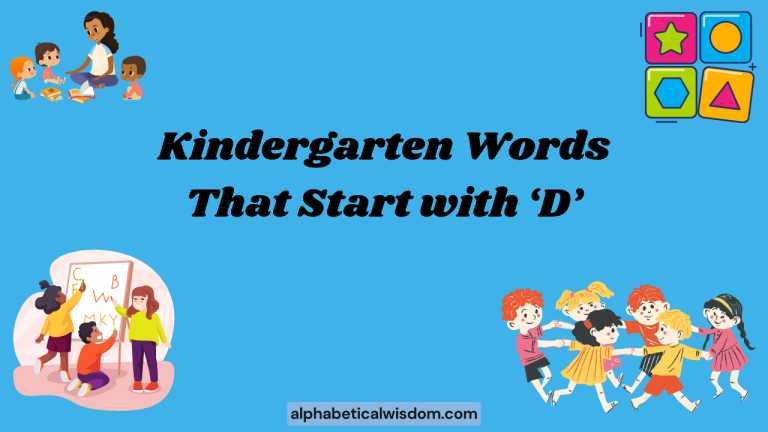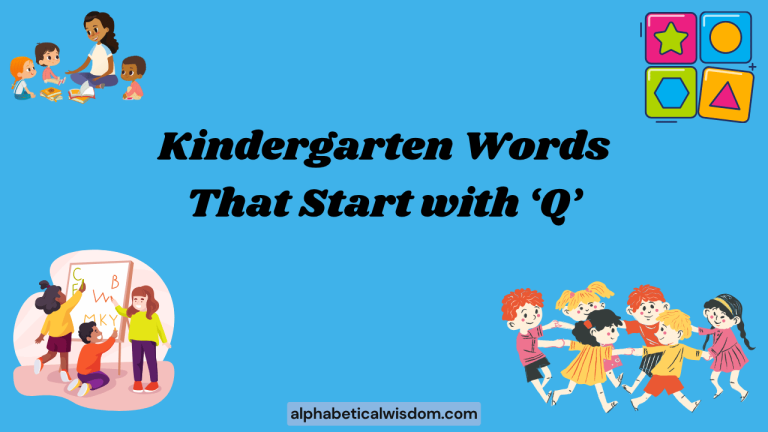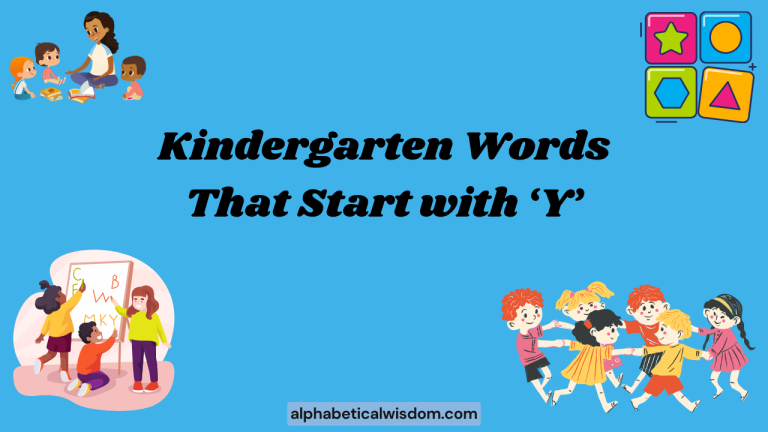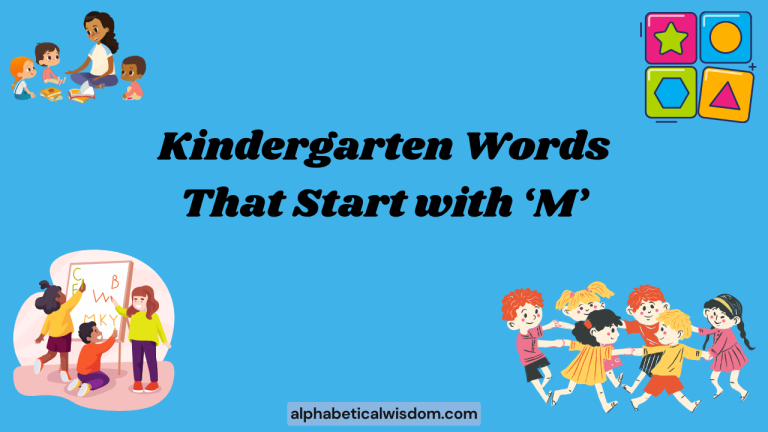Kindergarten Words That Start With L: A Comprehensive Guide
Learning new words is a crucial part of a child’s development, especially during kindergarten. Words that start with the letter ‘L’ are particularly important as they appear frequently in everyday language.
This guide provides a comprehensive overview of kindergarten-appropriate words beginning with ‘L,’ helping children expand their vocabulary and improve their reading and writing skills. This article benefits parents, teachers, and young learners by offering clear definitions, examples, and practice exercises designed to make learning fun and effective.
Table of Contents
- Introduction
- Definition of Kindergarten Words Starting with L
- Structural Breakdown of Words Starting with L
- Types and Categories of “L” Words
- Examples of Kindergarten Words Starting with L
- Usage Rules for Words Starting with L
- Common Mistakes When Using “L” Words
- Practice Exercises
- Advanced Topics: Exploring Word Families
- Frequently Asked Questions (FAQ)
- Conclusion
Definition of Kindergarten Words Starting with L
Kindergarten words starting with the letter ‘L’ are vocabulary terms that are appropriate and understandable for children aged 5-6 years old. These words typically consist of simple nouns, verbs, adjectives, and adverbs that are commonly used in everyday conversations and early reading materials.
The primary function of introducing these words is to build a foundational vocabulary that supports literacy development, comprehension, and effective communication. These words are often concrete and relate to the child’s immediate environment and experiences.
The letter ‘L’ is the twelfth letter of the English alphabet and often produces a distinct sound that is relatively easy for young children to pronounce. Words starting with ‘L’ are frequently used in stories, rhymes, and educational activities designed for this age group.
The contexts in which these words are used are typically simple and straightforward, aiding comprehension and retention. Introducing these words early helps children develop a strong base for future language learning.
Structural Breakdown of Words Starting with L
The structural breakdown of words starting with ‘L’ involves understanding the basic phonetic and grammatical elements. Most words in this category are simple, consisting of one or two syllables.
Phonetically, the ‘L’ sound can be either a clear ‘L’ as in ‘lion’ or a ‘dark L’ sound when it appears at the end of a word, as in ‘ball’. Grammatically, these words can function as different parts of speech, including nouns (e.g., leaf), verbs (e.g., look), adjectives (e.g., little), and adverbs (e.g., loudly).
Understanding the structure helps children recognize patterns and predict the meaning of new words. For example, knowing that ‘like’ is a verb can help them understand how it functions in a sentence.
Similarly, recognizing that ‘large’ is an adjective helps them understand that it describes a noun. This structural understanding is crucial for building reading fluency and writing skills.
The phonetic awareness of the ‘L’ sound also helps with pronunciation and spelling accuracy.
Types and Categories of “L” Words
Nouns
Nouns are words that represent people, places, things, or ideas. Kindergarten-appropriate nouns starting with ‘L’ are typically concrete objects or beings that children can easily visualize and understand.
These nouns form the basis of simple sentences and stories, helping children describe their world.
Verbs
Verbs are words that describe actions or states of being. Kindergarten verbs starting with ‘L’ often represent simple actions that children perform or observe daily.
These verbs add dynamism to sentences and help children understand the concept of action and movement.
Adjectives
Adjectives are words that describe nouns, providing more detail and information about them. Kindergarten adjectives starting with ‘L’ are usually simple descriptive words that children can easily relate to.
These adjectives help children express themselves more vividly and understand the qualities of objects and beings.
Adverbs
Adverbs are words that modify verbs, adjectives, or other adverbs, providing more information about how, when, where, or to what extent something is done. While less common in early kindergarten vocabulary, some simple adverbs starting with ‘L’ can be introduced to enrich sentence structure and comprehension.
These adverbs help children understand the nuances of actions and descriptions.
Examples of Kindergarten Words Starting with L
Nouns Examples
The following table provides examples of nouns starting with the letter ‘L’ that are suitable for kindergarten children. These nouns are common, easily recognizable, and frequently used in children’s literature and everyday conversation.
| Noun | Description |
|---|---|
| Leaf | A flat, typically green part of a plant. |
| Lion | A large, carnivorous feline animal. |
| Lamp | A device that provides light. |
| Lake | A large body of water surrounded by land. |
| Ladder | A structure used for climbing up or down. |
| Lunch | A midday meal. |
| Leg | A limb used for standing and walking. |
| Lemon | A yellow citrus fruit. |
| Lock | A device used to secure something. |
| Ladybug | A small, round beetle, typically red with black spots. |
| Land | The part of the earth’s surface that is not covered by water. |
| Line | A long, narrow mark or band. |
| Lip | Either of the two fleshy parts forming the edge of the mouth. |
| List | A series of names, items, or numbers written down. |
| Letter | A character representing one or more of the sounds used in speech; a written communication. |
| Light | The natural agent that stimulates sight and makes things visible. |
| Lobster | A large marine crustacean with a cylindrical body, stalked eyes, and large pincers. |
| Log | A portion of the trunk or a large branch of a tree that has fallen or been cut off. |
| Lollipop | A hard candy on a stick. |
| Loop | A shape produced by a curve that bends round and crosses itself. |
| Lace | A delicate fabric made of yarn or thread in an open weblike pattern, made by machine or by hand. |
| Lamb | A young sheep. |
| Lantern | A lamp with a transparent case protecting the flame or bulb. |
| Lap | The front of the body from the waist to the knees when in a sitting position. |
| Laundry | Clothes and linens that need to be washed or have been newly washed. |
| Law | A system of rules that are enforced through social institutions to govern behavior. |
| Leather | A material made from the skin of an animal by tanning or a similar process. |
| Lettuce | A cultivated plant of the daisy family, with edible leaves that are eaten in salads. |
| Library | A building or room containing a collection of books and other printed material for reading or borrowing. |
Verbs Examples
The table below presents verbs starting with ‘L’ that are suitable for kindergarten vocabulary. These verbs describe simple actions that children can understand and relate to, making them useful for building basic sentence structures.
| Verb | Description |
|---|---|
| Look | To direct one’s gaze towards something or someone. |
| Like | To find something pleasant or enjoyable. |
| Listen | To pay attention to sound. |
| Laugh | To make sounds and movements of the face showing amusement. |
| Learn | To acquire knowledge or skill through study, experience, or being taught. |
| Let | To allow or permit. |
| Lie | To be in or assume a horizontal or resting position. |
| Lift | Raise to a higher position or level. |
| Light | Ignite or set fire to. |
| Load | Put a load on or in (something). |
| Lock | Fasten or secure (something) with a lock. |
| Lose | Be deprived of (something) or cease to have or retain (something). |
| Love | Have a strong feeling of affection for (someone). |
| Land | Come down to earth; alight. |
| Label | Attach a label to (something). |
| Lace | Fasten (shoes or clothing) with laces. |
| Lick | Pass the tongue over (something) in order to taste, moisten, or clean it. |
| Limit | Set a limit to. |
| Limp | Walk with difficulty, typically because of injury or stiffness. |
| Linger | Stay in a place longer than necessary, typically because of a reluctance to leave. |
| Link | Make a connection between two or more things. |
| List | Make a list of. |
| Liven | Make (something) more lively or exciting. |
| Locate | Discover the exact place or position of. |
| Long | Have a strong desire or craving. |
| Loosen | Make or become less tight or firm. |
| Lower | Move (someone or something) in a downward direction. |
| Lumber | Move in a slow, heavy, awkward way. |
| Lurk | Be or remain hidden so as to wait in ambush for someone or something. |
Adjectives Examples
This table provides examples of adjectives that start with the letter ‘L’ and are suitable for kindergarten children. These adjectives are used to describe nouns and add detail to sentences, helping children expand their descriptive vocabulary.
| Adjective | Description |
|---|---|
| Little | Small in size. |
| Large | Of considerable size. |
| Long | Measuring a great distance from end to end. |
| Loud | Producing a great deal of noise. |
| Lovely | Beautiful or attractive. |
| Lazy | Unwilling to work or use energy. |
| Light | Having little weight. |
| Late | Occurring after the expected or usual time. |
| Loose | Not tightly fastened or held. |
| Lucky | Having good fortune. |
| Lean | Thin, especially healthily so; having little fat. |
| Legal | Permitted by law. |
| Lesser | Smaller; not so great or important as the other or others. |
| Level | Having a flat and even surface without slopes or bumps. |
| Liberal | Open to new behavior or opinions and willing to discard traditional values. |
| Lifeless | Dead or apparently dead. |
| Likely | Having a high probability of occurring or being true. |
| Limited | Restricted in size, amount, or extent; few, small, or short. |
| Liquid | Having a consistency like that of water or oil; flowing freely but of constant volume. |
| Literate | Able to read and write. |
| Live | (of a broadcast) transmitted at the time of the event. |
| Livid | Furiously angry. |
| Lonely | Sad because one has no friends or company. |
| Looping | Forming loops. |
| Lost | Unable to find one’s way; no longer possessed or retained. |
| Loyal | Giving or showing firm and constant support or allegiance to a person or institution. |
| Lucid | Expressed clearly; easy to understand. |
| Luminous | Full of light; bright or shining. |
| Lunar | Relating to the moon. |
Examples in Sentences
The following table provides example sentences using kindergarten words that start with ‘L’. These sentences demonstrate how these words can be used in context, aiding comprehension and usage.
| Sentence | Word Starting with L |
|---|---|
| The lion is the king of the jungle. | Lion |
| I like to eat apples. | Like |
| The leaf fell from the tree. | Leaf |
| Please listen to the teacher. | Listen |
| The lamp gives off light. | Lamp |
| The lake is very big. | Lake |
| I can laugh when I am happy. | Laugh |
| The boy climbed the ladder. | Ladder |
| We eat lunch at noon. | Lunch |
| My leg helps me walk. | Leg |
| This lemon is very sour. | Lemon |
| Use the lock to keep it safe. | Lock |
| The ladybug is red and black. | Ladybug |
| The land is green and brown. | Land |
| Draw a straight line. | Line |
| My lip is red. | Lip |
| Make a list of groceries. | List |
| The letter is A. | Letter |
| Turn on the light. | Light |
| The lobster lives in the sea. | Lobster |
| The log is heavy. | Log |
| I like to eat a lollipop. | Lollipop |
| The string made a loop. | Loop |
| The dress has lace. | Lace |
| The lamb is a baby sheep. | Lamb |
| The lantern is bright. | Lantern |
| Sit on my lap. | Lap |
| Do the laundry. | Laundry |
| Follow the law. | Law |
| The bag is made of leather. | Leather |
| I like lettuce in my salad. | Lettuce |
| Go to the library to read books. | Library |
Usage Rules for Words Starting with L
When using words starting with ‘L,’ it’s important to follow basic grammar rules. Nouns should be used to name people, places, or things, and they often require articles (a, an, the).
Verbs should be used to describe actions or states of being, and they must agree with the subject of the sentence. Adjectives should be used to describe nouns, and they usually come before the noun they modify.
Adverbs should be used to modify verbs, adjectives, or other adverbs, and their placement in the sentence can vary.
Exceptions and Special Cases: Some words starting with ‘L’ may have irregular plural forms or verb conjugations. For instance, the plural of ‘leaf’ is ‘leaves.’ Some verbs may have irregular past tense forms. It’s also crucial to pay attention to context, as some words can function as different parts of speech depending on how they are used in a sentence. For example, ‘light’ can be a noun (the light from the lamp) or a verb (to light a candle).
Additionally, be mindful of the correct spelling. The letter ‘L’ can sometimes be doubled, as in ‘lollipop,’ and it’s essential to remember these spellings.
Regularly practicing reading and writing these words can help reinforce correct usage and spelling.
Common Mistakes When Using “L” Words
One common mistake is confusing words that sound similar but have different meanings (homophones). For example, ‘lose’ and ‘loose’ are often confused.
‘Lose’ means to be deprived of something, while ‘loose’ means not tightly fastened. Another common mistake is incorrect spelling, such as writing ‘lef’ instead of ‘leaf’.
Verb tense errors are also frequent, such as saying “I likeed” instead of “I liked.”
Correct vs. Incorrect Examples:
- Incorrect: The dog is to lose. Correct: The dog is too loose.
- Incorrect: I saw a green lef. Correct: I saw a green leaf.
- Incorrect: Yesterday, I likeed the movie. Correct: Yesterday, I liked the movie.
- Incorrect: He is loud than me. Correct: He is louder than me.
To avoid these mistakes, encourage children to practice writing and spelling these words regularly. Provide opportunities for them to use these words in sentences and stories.
Correcting errors gently and providing clear explanations can help reinforce correct usage.
Practice Exercises
Exercise 1: Fill in the Blanks
Fill in the blanks with the correct word from the word bank. Word Bank: lion, leaf, like, listen, lamp.
| Question | Answer |
|---|---|
| 1. The ______ is the king of the jungle. | lion |
| 2. I ______ to read books. | like |
| 3. The ______ fell off the tree. | leaf |
| 4. Please ______ to your teacher. | listen |
| 5. The ______ helps me see in the dark. | lamp |
| 6. The color of ______ is yellow. | lemon |
| 7. The ______ is big and blue. | lake |
| 8. Please turn on the ______. | light |
| 9. The ______ protects the door. | lock |
| 10. The ______ is used for climbing. | ladder |
Exercise 2: Matching Game
Match the word with its correct definition.
| Word | Definition | Answer |
|---|---|---|
| 1. Large | A. To pay attention to sound | 1. B |
| 2. Listen | B. Of considerable size | 2. A |
| 3. Little | C. A device that provides light | 3. E |
| 4. Leaf | D. A midday meal | 4. F |
| 5. Lamp | E. Small in size | 5. C |
| 6. Lunch | F. A flat, green part of a plant | 6. D |
| 7. Long | G. Happy and funny | 7. I |
| 8. Loud | H. Not tight | 8. J |
| 9. Laugh | I. Measuring a great distance from end to end | 9. G |
| 10. Loose | J. Producing a great deal of noise | 10. H |
Exercise 3: Sentence Creation
Create a sentence using each of the following words. Example: Leaf: The green leaf fell from the tree.
| Word | Sentence |
|---|---|
| 1. Lion | The lion roared loudly in the zoo. |
| 2. Like | I like to play with my toys. |
| 3. Lamp | The lamp on the table gives off a soft light. |
| 4. Listen | Please listen carefully to the instructions. |
| 5. Little | The little bird flew away. |
| 6. Leg | I hurt my leg when I fell. |
| 7. Letter | I wrote a letter to my friend. |
| 8. Lollipop | The lollipop is sweet. |
| 9. Late | I am late for school. |
| 10. Land | The land is green. |
Advanced Topics: Exploring Word Families
For advanced learners, exploring word families can be a great way to expand vocabulary. Word families are groups of words that share a common root or base word.
For example, the word ‘light’ can be part of a word family that includes ‘lighter,’ ‘lighting,’ and ‘lightly.’ Understanding these relationships can help children infer the meanings of new words and build their overall language skills.
Another advanced topic is exploring compound words that start with ‘L,’ such as ‘ladybug’ or ‘lollipop.’ Breaking down these words into their component parts can help children understand how words are formed and expand their vocabulary. Additionally, children can learn about idioms or figurative language that use words starting with ‘L,’ such as “a lion’s share” or “last but not least.”
Finally, encouraging children to use these words in creative writing activities, such as writing stories or poems, can help them deepen their understanding and master their usage. These advanced activities can foster a love of language and promote lifelong learning.
Frequently Asked Questions (FAQ)
- Q: Why is it important for kindergarteners to learn words starting with ‘L’?
A: Learning words starting with ‘L’ helps kindergarteners build a strong foundational vocabulary, which is crucial for reading, writing, and communication skills. These words are frequently used in everyday language and early reading materials, making them essential for literacy development.
- Q: How can I make learning ‘L’ words fun for my child?
A: You can make learning fun by using games, flashcards, and interactive activities. Reading books together and pointing out words starting with ‘L’ can also be effective. Encourage your child to use these words in sentences and stories to reinforce their understanding.
- Q: What are some common mistakes children make when using ‘L’ words?
A: Common mistakes include confusing homophones like ‘lose’ and ‘loose,’ misspelling words like ‘leaf,’ and making verb tense errors. Regularly practicing writing and using these words in context can help avoid these mistakes.
- Q: How can I help my child improve their pronunciation of ‘L’ words?
A: Practice pronouncing ‘L’ words slowly and clearly with your child. Pay attention to the different sounds the letter ‘L’ can make, such as the clear ‘L’ in ‘lion’ and the dark ‘L’ in ‘ball.’ Use online resources or apps that provide audio pronunciations.
- Q: Are there any specific strategies for teaching ‘L’ words to children with learning disabilities?
A: Use multisensory approaches, such as visual aids, tactile activities, and auditory reinforcement. Break down words into smaller parts and focus on one word at a time. Provide plenty of repetition and positive reinforcement. Consult with a special education professional for additional support.
- Q: How many ‘L’ words should a kindergartener know?
A: There is no specific number, but a good goal is to introduce and reinforce at least 20-30 commonly used ‘L’ words. Focus on quality over quantity, ensuring that the child understands the meaning and usage of each word.
- Q: What are some good books for kindergarteners that feature words starting with ‘L’?
A: Look for books with simple language and engaging illustrations. Some popular choices include books about lions, lambs, and other animals, as well as books that focus on everyday activities like going to the library or eating lunch.
- Q: How can I incorporate ‘L’ words into daily activities?
A: Use ‘L’ words in your everyday conversations with your child. Point out objects that start with ‘L’ and describe them using adjectives that start with ‘L.’ Play games like “I Spy” using ‘L’ words. For example, “I spy something little that starts with L.”
- Q: What is the difference between the ‘L’ sound at the beginning versus the end of a word?
A: The ‘L’ sound at the beginning of a word (like in ‘lion’) is typically a clear, distinct sound. The ‘L’ sound at the end of a word (like in ‘ball’) can be a “dark L” sound, which is produced further back in the mouth and can sound slightly different.
- Q: How can I assess my child’s understanding of ‘L’ words?
A: Use simple quizzes, matching games, and sentence completion exercises to assess your child’s understanding. Ask them to define ‘L’ words and use them in sentences. Observe their usage of ‘L’ words in their everyday conversations and writing.
Conclusion
Mastering kindergarten words that start with ‘L’ is a fundamental step in a child’s language development. This comprehensive guide provides a clear understanding of these words, their structures, and their usage through detailed examples and practical exercises.
By focusing on nouns, verbs, adjectives, and adverbs, children can build a solid foundation for future language learning. Remember to make learning fun and engaging by incorporating games, stories, and everyday conversations.
Regular practice and positive reinforcement are key to success. Encourage children to use these words in their writing and speaking, and provide gentle correction when needed.
By following the tips and strategies outlined in this guide, parents and educators can help young learners confidently expand their vocabulary and improve their overall literacy skills. Continue to explore new words and word families to foster a lifelong love of language and learning.
